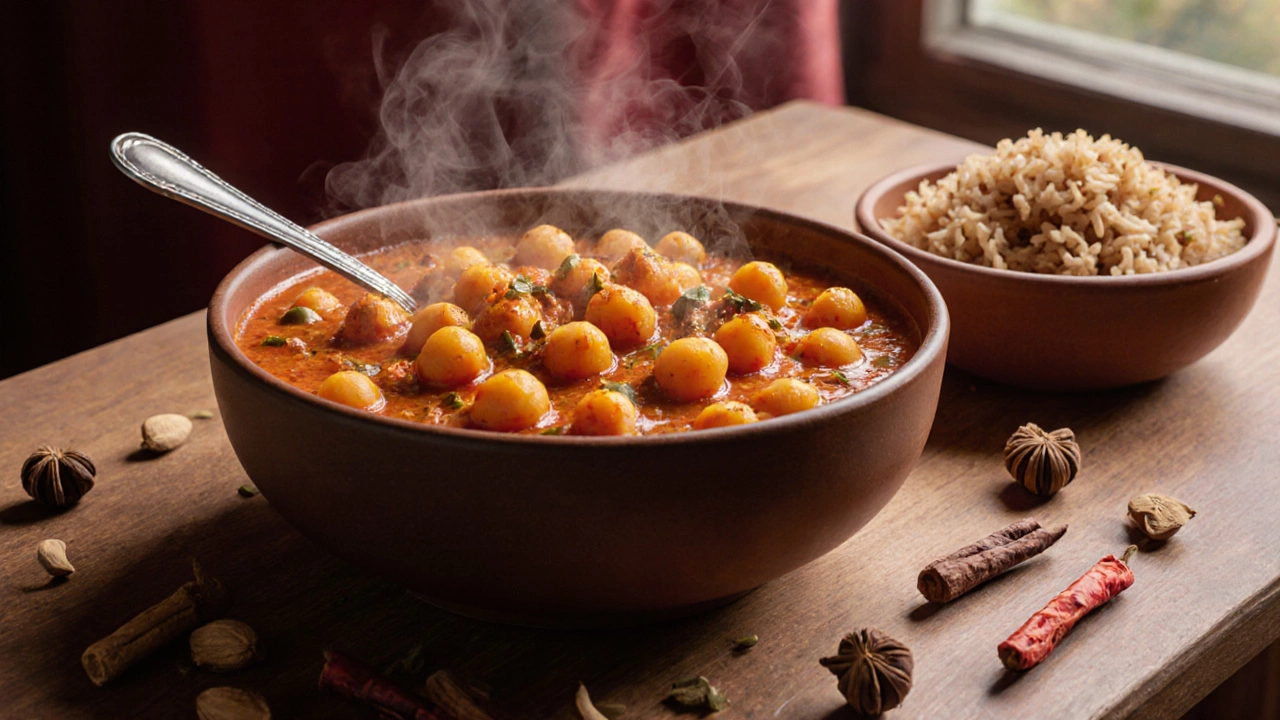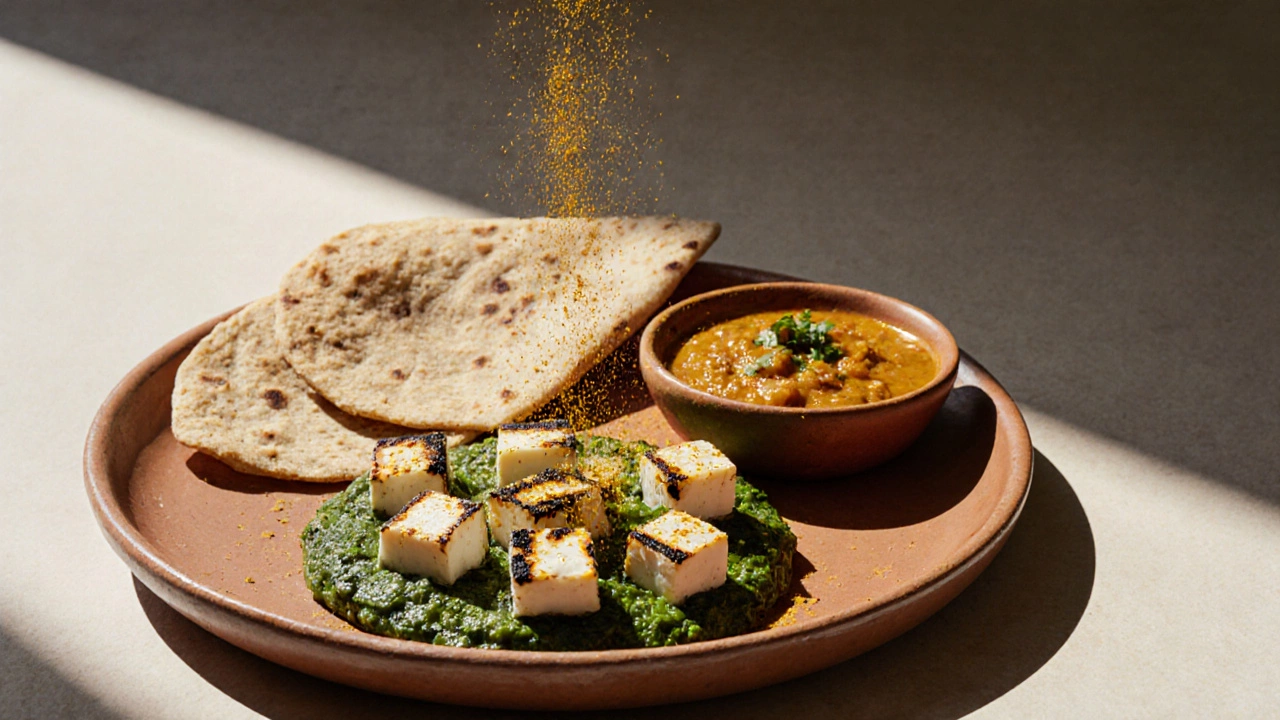Indian Meal Calculator
Calculate Your Order
Estimate calories, protein, and fiber based on your choices
Your Meal Nutrition
Total Calories
0
Protein
0g
Fiber
0g
This order has 25% more fiber than typical restaurant portions
Tip: Your meal contains 200mg of turmeric for anti-inflammatory benefits
If you’ve ever sat in an Indian restaurant wondering what to order without guilt, you’re not alone. The rich aromas, colorful curries, and crispy breads are tempting-but not all Indian food is created equal when it comes to health. The truth? Indian cuisine has some of the most nutrient-dense dishes on the planet, but it also has plenty of fried, butter-heavy options that can undo all the good stuff. So what’s the healthiest Indian food to order? It’s not about skipping flavor-it’s about choosing wisely.
Tandoori Chicken: The Gold Standard
Tandoori chicken is the standout when you want flavor without the fat. It’s made by marinating chicken in yogurt, lemon juice, garlic, ginger, and a blend of spices like turmeric, cumin, coriander, and paprika. Then it’s cooked in a clay oven called a tandoor. The result? Juicy, smoky, and packed with protein-without the oil bath that many other dishes get.
Unlike fried chicken or butter chicken, tandoori chicken doesn’t soak in ghee or cream. A 100-gram serving has about 165 calories, 31 grams of protein, and just 4 grams of fat. That’s more protein than a grilled chicken breast from most Western restaurants. Plus, the yogurt marinade contains probiotics that help digestion. If you’re ordering at a restaurant, ask for it without skin to cut even more fat. Skip the side of naan or rice unless you’re truly hungry-this dish stands strong on its own.
Chana Masala: Plant-Powered Protein
If you’re looking for something vegetarian that still fills you up, chana masala is your best bet. It’s made with chickpeas cooked in a spiced tomato-onion gravy with cumin, coriander, garam masala, and a touch of chili. Chickpeas are a powerhouse: one cup gives you 15 grams of fiber and 14 grams of protein. That’s more fiber than a bowl of oatmeal and more protein than an egg.
What makes this dish even better? It’s naturally low in fat unless the restaurant adds cream or butter at the end. Ask for it "no cream, no butter"-most places will honor that. The spices in chana masala aren’t just for taste; turmeric has anti-inflammatory properties, and cumin aids digestion. Pair it with a side of plain steamed brown rice or quinoa for a balanced, blood-sugar-friendly meal.
Palak Paneer (Made Right)
Palak paneer sounds healthy-spinach and cheese, right? But here’s the catch: many restaurants make it with heavy cream, lots of butter, and paneer fried before adding it to the sauce. That turns a nutrient-rich dish into a calorie bomb.
Ask for "palak paneer without cream, with grilled paneer." When made properly, it’s a win. Spinach is loaded with iron, vitamin K, and folate. Paneer, when grilled instead of fried, is a clean source of casein protein. A serving made with minimal oil has about 200-250 calories, 18 grams of protein, and over 50% of your daily iron needs. Skip the version that looks oily or has a creamy sheen-it’s not healthier, just heavier.

Dal Tadka: The Humble Hero
Dal, or lentil stew, is the everyday comfort food of India-and one of the most nutritious. Dal tadka is made by simmering split red lentils (masoor dal) until soft, then tempering them with mustard seeds, cumin, garlic, and dried red chilies in a small amount of ghee or oil.
One cup of dal tadka gives you 18 grams of protein and 15 grams of fiber. That’s more fiber than a whole grain bagel. Lentils are also rich in folate, magnesium, and slow-digesting carbs that keep you full for hours. The tadka (tempering) adds flavor without bulk. Most restaurants use just a teaspoon of oil for the whole pot-so even if it’s not perfect, it’s still far better than most curries.
Pro tip: Order dal tadka with a side of plain rice or roti made from whole wheat. Avoid versions labeled "extra creamy" or "rich"-those are loaded with cream or butter.
Vegetable Biryani (The Smart Version)
Biryani often gets a bad rap because it’s made with ghee, fried onions, and white rice. But you can still enjoy it if you know how to order it right. Look for "vegetable biryani made with brown rice, less oil, no fried onions."
Traditional biryani uses white rice, which spikes blood sugar and offers little fiber. Brown rice, on the other hand, keeps you full longer and supports gut health. A well-made vegetable biryani with brown rice, carrots, peas, potatoes, and whole spices like cardamom and cloves can be a nutrient-dense meal. It’s packed with antioxidants from the veggies and complex carbs from the rice.
Ask the server if they can skip the fried onions and use less oil. Most places will do it if you ask. A serving of this version has around 300-350 calories-much better than the 500+ you get from the classic version.
What to Avoid
Even in a healthy Indian meal, some dishes sabotage your goals. Here’s what to skip:
- Butter chicken - Smothered in cream, butter, and sugar. One serving can have 600+ calories and 40 grams of fat.
- Samosas and pakoras - Deep-fried snacks loaded with refined flour and oil. Even vegetable ones are calorie traps.
- Naan - Usually baked with butter or ghee and made from white flour. Opt for roti instead.
- Raita with sour cream - Many restaurants use full-fat yogurt or even sour cream. Ask for plain yogurt raita with cucumber and mint.
- Paneer tikka masala - Often made with fried paneer and heavy cream. Stick to tandoori paneer instead.

How to Order Like a Pro
Here’s a simple script you can use at any Indian restaurant:
- Start with tandoori chicken or grilled paneer as your protein.
- Pair it with chana masala or dal tadka for plant-based nutrition.
- Ask for brown rice or whole wheat roti instead of white rice or naan.
- Request no cream, no butter, and no fried onions in curries.
- Skip the fried appetizers and go for a simple cucumber-tomato salad with lemon.
Most Indian restaurants are happy to adjust dishes-they cook from scratch. Don’t be shy. Saying "no cream, no butter" doesn’t make you difficult. It makes you informed.
Why This Matters Beyond Calories
Choosing healthy Indian food isn’t just about weight. It’s about energy, digestion, and long-term health. The spices used in Indian cooking-turmeric, cumin, fenugreek, black pepper-have been studied for their anti-inflammatory and metabolic benefits. A 2023 study in the Journal of Nutrition & Food Sciences found that people who ate Indian meals with turmeric and ginger regularly had lower markers of inflammation than those who didn’t.
Plus, the high fiber content in lentils, chickpeas, and vegetables helps stabilize blood sugar. That means fewer cravings, less mid-afternoon crash, and better gut health. In a world full of processed meals, Indian food-when ordered right-is one of the most healing cuisines you can eat.
Final Tip: Portion Control Still Counts
Even healthy food can lead to weight gain if you eat too much. Indian portions at restaurants are often huge. Order one main dish and one side. Share a curry with a friend. Take half home. You don’t need to clean your plate to enjoy the meal.
The healthiest Indian food isn’t about perfection-it’s about making smart swaps. Swap fried for grilled. Swap cream for spice. Swap white rice for brown. You’ll eat better, feel better, and still get all the bold, comforting flavors you love.
Is tandoori chicken really healthy?
Yes, tandoori chicken is one of the healthiest Indian dishes when ordered without skin. It’s high in protein, low in fat, and cooked without deep frying. The yogurt marinade adds probiotics, and the spices have anti-inflammatory benefits. A 100-gram serving has around 165 calories and 31 grams of protein.
What’s the healthiest Indian curry?
Chana masala and dal tadka are the healthiest curries. Both are made with lentils or chickpeas, which are high in fiber and plant-based protein. They’re naturally low in fat unless cream or butter is added. Ask for no cream and no extra oil to keep them nutritious.
Is Indian food good for weight loss?
Yes, if you choose wisely. Dishes like tandoori chicken, chana masala, dal, and grilled vegetables are high in protein and fiber, which help you feel full longer. Avoid fried items, creamy curries, and white bread. Stick to whole grains, lean proteins, and spices-and you’ll be eating a diet that supports weight loss.
Can I eat Indian food if I’m diabetic?
Absolutely. Focus on high-fiber foods like lentils, chickpeas, and vegetables. Choose brown rice or whole wheat roti over white rice and naan. Avoid sugary chutneys and creamy sauces. Dishes like dal tadka and chana masala have a low glycemic index and help stabilize blood sugar.
What’s better: brown rice or roti?
Both are good, but whole wheat roti has slightly more fiber and protein per serving. Brown rice is better for portion control since it’s easier to measure. If you’re eating one curry, one roti is enough. If you’re eating two sides, go with half a cup of brown rice. Neither is perfect-choose based on what you’re pairing it with.
